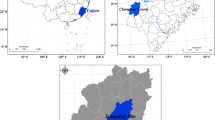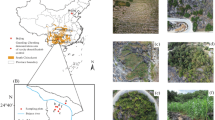Abstract
Background and aims
Microbial community characterization is used as a disturbance indicator for soils. However, there is little evidence on the response of soil microbes to restoration. We aim to study the effects of restoration, using different trees, on soil communities and document temporal changes.
Methods
On a phosphate mine in Yunnan Province, China we selected sites with different restoration ages (2, 23, and 30 years) and tree species (Eucalyptus globulus (exotic), Cupressus torulosa, Pinus yunnanensis (both indigenous)). Control sites included natural land, and disturbed sites without vegetation. Soil microbial communities were characterized using Phospholipid-derived fatty acids analysis. Soil nutrients concentrations were analysed.
Results
Compared to control sites, disturbed soils exhibited significantly lower microbial diversity, bacterial biomass, soil organic carbon and nutrient concentrations. Recultivation with trees restored the soil microbial communities to a state similar to natural soils. Indigenous trees increased soil N concentration, and microbial biomass at a faster rate than the exotic Eucalyptus trees. Soil microbial diversity increased with plantation age.
Conclusion
Soil communities can be used as soil health indicators in restoration monitoring. Additionally, soil microbial communities recovered fastest under indigenous compared to exotic trees, which further underlines the importance of tree species selection in restoration management.




Similar content being viewed by others
References
Allen SE (1989) Chemical analysis of ecological materials. Blackwell Scientific publications, Oxford
Andrews RL, Broome SW (2006) Oak flat restoration on phosphate‐mine spoils. Restor Ecol 14:210–219
Aponte C, García LV, Marañón T (2013) Tree species effects on nutrient cycling and soil biota: a feedback mechanism favoring species coexistence. Forest Ecol Manag 309:36–46
Banning NC, Murphy DV (2008) Effect of heat-induced disturbance on microbial biomass and activity in forest soil and the relationship between disturbance effects and microbial community structure. Appl Soil Ecol 40:109–119
Banning NC, Gleeson DB, Grigg AH, Grant CD, Andersen GL, Brodie EL, Murphy DV (2011) Soil microbial community successional patterns during forest ecosystem restoration. Appl Environ Microb 77:6158–6164
Bardgett RD, Bowman WD, Kaufmann R, Schmidt SK (2005) A temporal approach to linking aboveground and belowground ecology. Trends Ecol Evol 20:634–641
Bossio DA, Scow KM (1998) Impacts of carbon and flooding on soil microbial communities: phospholipid fatty acid profiles and substrate utilization patterns. Microb Ecol 35:265–278
Brant JB, Myrold DD, Sulzman EW (2006) Root controls on soil microbial community structure in forest soils. Oecologia 148:650–659
Briones MJI, Ineson P (1996) Decomposition of eucalyptus leaves in litter mixtures. Soil Biol Biochem 28:1381–1388
Buee M, Reich M, Murat C, Morin E, Nilsson RH, Uroz S, Martin F (2009) 454 Pyrosequencing analyses of forest soils reveal an unexpectedly high fungal diversity. New Phytol 184:449–456
Canhoto C, Graça MAS (1999) Leaf barriers to fungal colonization and shredders (Tipula lateralis) consumption of decomposing Eucalyptus globulus. Microb Ecol 37:163–172
Chander K, Brookes PC (1991) Plant inputs of carbon to metal-contaminated soil and effects on the soil microbial biomass. Soil Biol Biochem 23:1169–1177
Chodak M, Niklińska M (2010) Effect of texture and tree species on microbial properties of mine soils. Appl Soil Ecol 46:268–275
Chu CJ, Mortimer PE, Wang HC, Wang YF, Liu XB, Yu SX (2014) Allelopathic effects of Eucalyptus on native and introduced tree species. Forest Ecol Manag 323:79–84
D’Antonio C, Meyerson LA (2002) Exotic plant species as problems and solutions in ecological restoration: a synthesis. Restor Ecol 10:703–713
Daehler CC (2003) Performance comparisons of co-occurring native and alien invasive plants: implications for conservation and restoration. Annu Rev Ecol Evol S 2003:183–211
Dakora FD, Phillips DA (2002) Root exudates as mediators of mineral acquisition in low-nutrient environments. Plant Soil 245:35–47
DeGrood SH, Claassen VP, Scow KM (2005) Microbial community composition on native and drastically disturbed serpentine soils. Soil Biol Biochem 37:1427–1435
Ehrenfeld JG, Ravit B, Elgersma K (2005) Feedback in the plant-soil system. Annu Rev Environ Resour 30:75–115
Food and Agricultural Organization of the UN (FAO) (2006) Guidelines on food fortification with micronutrients. http://www.who.int/nutrition/publications/micronutrients/9241594012/en/
Gianinazzi S, Gollotte A, Binet MN, van Tuinen D, Redecker D, Wipf D (2010) Agroecology: the key role of arbuscular mycorrhizas in ecosystem services. Mycorrhiza 20:519–530
Hill TC, Walsh KA, Harris JA, Moffett BF (2003) Using ecological diversity measures with bacterial communities. FEMS Microb Ecol 43:1–11
Hossain Z, Sugiyama S (2011) Geographical structure of soil microbial communities in northern Japan: effects of distance, land use type and soil properties. Eur J Soil Biol 47:88–94
Jangid K, Williams MA, Franzluebbers AJ, Schmidt TM, Coleman DC, Whitman WB (2011) Land-use history has a stronger impact on soil microbial community composition than aboveground vegetation and soil properties. Soil Biol Biochem 43:2184–2193
Jiang G, Zheng X, Hu Y (2012) Forest health assessment in the Badaling Forest Farm of Beijing based on GIS and RS. JDCTA 6:87–93
Kowalchuk GA, Buma DS, de Boer W, Klinkhamer PGL, van Veen JA (2002) Effects of above-ground plant species composition and diversity on the diversity of soil-borne microorganisms. Anton Leeuw Int J Gen Mol Microbiol 81:509–520
Kulmatiski A, Beard KH (2011) Long-term plant growth legacies overwhelm short-term plant growth effects on soil microbial community structure. Soil Biol Biochem 43:823–830
Marschner P, Crowley D, Yang CH (2004) Development of specific rhizosphere bacterial communities in relation to plant species, nutrition and soil type. Plant Soil 261:199–208
Matula J (1996) Determination of potassium, magnesium, phosphorus, manganese and cation exchange capacity for fertilizer recommendations used by Czech Union of Rapeseed Growers. Commun Soil Sci Plant 27:1679–1691
Mendes R, Garbeva P, Raaijmakers JM (2013) The rhizosphere microbiome: significance of plant beneficial, plant pathogenic, and human pathogenic microorganisms. FEMS Microb Rev 37:634–663
Mummey DL, Stahl PD, Buyer JS (2002a) Microbial biomarkers as an indicator of ecosystem recovery following surface mine reclamation. Appl Soil Ecol 21:251–259
Mummey DL, Stahl PD, Buyer JS (2002b) Soil microbiological properties 20 years after surface mine reclamation: spatial analysis of reclaimed and undisturbed sites. Soil Biol Biochem 34:1717–1725
O’Donnell AG, Seasman M, Macrae A, Waite I, Davies JT (2001) Plants and fertilisers as drivers of change in microbial community structure and function in soils. Plant Soil 232:135–145
Palfner G, Casanova-Katny MA, Read DJ (2005) The mycorrhizal community in a forest chronosequence of Sitka spruce [Picea sitchensis (Bong.) Carr.] in Northern England[J]. Mycorrhiza 15:571–579
Parkinson JA, Allen SE (1975) A wet oxidation procedure suitable for the determination of nitrogen and mineral nutrients in biological material. Commun Soil Sci Plan 6:1–11
Ponder F Jr, Tadros M (2002) Phospholipid fatty acids in forest soil 4 years after organic matter removal and soil compaction. Appl Soil Ecol 19:173–182
Rodriguez-Loinaz G, Onaindia M, Amezaga I, Mijangos I, Garbisu C (2008) Relationship between vegetation diversity and soil functional diversity in native mixed-oak forests. Soil Biol Biochem 40:49–60
Shi LL, Mortimer PE, Slik JWF, Zou XM, Xu JC, Feng WT, Qiao L (2014) Variation in forest soil fungal diversity along a latitudinal gradient. Fungal Divers 64:305–315
Shrestha RK, Lal R (2006) Ecosystem carbon budgeting and soil carbon sequestration in reclaimed mine soil. Environ Int 32:781–796
Stohlgren TJ, Binkley D, Chong GW, Kalkhan MA, Schell LD, Bull KA, Otsuki Y, Newman G, Bashkin M, Son Y (1999) Exotic plant species invade hot spots of native plant diversity. Ecol Monogr 69:25–46
Styger E, Rakotoarimanana JEM, Rabevohitra R, Fernandes ECM (1999) Indigenous fruit trees of Madagascar: potential components of agroforestry systems to improve human nutrition and restore biological diversity. Agroforest Syst 46:289–310
Tscherko D, Rustemeier J, Richter A, Wanek W, Kandeler E (2003) Functional diversity of the soil microflora in primary succession across two glacier forelands in the Central Alps. Eur J Soil Sci 54:685–696
Tscherko D, Hammesfahr U, Marx MC, Kandelera E (2004) Shifts in rhizosphere microbial communities and enzyme activity of Poa alpine, across an alpine chronosequence. Soil Biol Biochem 36:1685–1698
Tunlid A, Hoitink HAJ, Low C, White DC (1989) Characterization of bacteria that suppress Rhizoctonia damping-off in bark compost media by analysis of fatty acid biomarkers. Appl Environ Microb 55:1368–1374
Turnbull JW (1999) Eucalypt plantations /Planted Forests: Contributions to the Quest for Sustainable Societies. Springer, Netherlands, pp 37–52
Twieg BD, Durall DM, Simard SW (2007) Ectomycorrhizal fungal succession in mixed temperate forests. New Phytol 176:437–447
Unger IM, Goyne KW, Kennedy AC, Kremer RJ, McLain JET, Williams FC (2013) Antibiotic effects on microbial community characteristics in soils under conservation management practices. Soil Sci Soc Am J 77:100–112
Van der Putten WH, Van Dijk C, Peters BAM (1993) Plant-specific soil-borne diseases contribute to succession in foredune vegetation. Nature 362:53–56
Van Kleunen M, Weber E, Fischer M (2010) A meta-analysis of trait differences between invasive and non-invasive plant species. Ecol Lett 13:235–245
Wallander H, Johansson U, Sterkenburg E, Durling MB, Lindahl BD (2010) Production of ectomycorrhizal mycelium peaks during canopy closure in Norway spruce forests. New Phytol 187:1124–1134
Ying JY, Zhang LM, Wei WX, He JZ (2013) Effects of land utilization patterns on soil microbial communities in an acid red soil based on DNA and PLFA analyses. J Soils Sediment 13:1223–1231
Acknowledgments
This study was funded through the support of the Chinese Ministry of Science and Technology, under the 12th 5-year National Key Technology Support Program (NKTSP) 2013BAB07B06 integration and comprehensive demonstration of key technologies on Green Phosphate-mountain Construction. We would also like to thank the CGIAR Research Program 6: Forest, Trees and Agroforestry, for partially funding this work.
Author information
Authors and Affiliations
Corresponding authors
Additional information
Responsible Editor: Eric Paterson.
Rights and permissions
About this article
Cite this article
Li, C., Shi, LL., Ostermann, A. et al. Indigenous trees restore soil microbial biomass at faster rates than exotic species. Plant Soil 396, 151–161 (2015). https://doi.org/10.1007/s11104-015-2570-x
Received:
Accepted:
Published:
Issue Date:
DOI: https://doi.org/10.1007/s11104-015-2570-x




